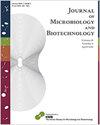Validation of Active Compound of Terminalia catappa L. Extract and Its AntiInflammatory and Antioxidant Properties by Regulating Mitochondrial Dysfunction and Cellular Signaling Pathways.
IF 2.5
4区 生物学
Q3 BIOTECHNOLOGY & APPLIED MICROBIOLOGY
引用次数: 0
Abstract
As chronic inflammation and oxidative stress cause various diseases in the human body, this study aimed to develop functional materials to prevent inflammation and oxidative stress. This study investigated the biological function and components of Terminalia catappa L. extract prepared using its leaves and branches (TCE). TCE was determined using ultraperformance liquid chromatographyquadrupole-time-of-flight mass spectrometry. Using RAW 264.7 mouse macrophages, inhibitory effects of the identified compounds on nitric oxide (NO) and reactive oxygen species (ROS) generation were analyzed. Therefore, α-punicalagin was selected as an active compound with the highest content (986.6 ± 68.4 μg/g) and physiological activity. TCE exhibited an inhibitory effect on lipopolysaccharide (LPS)-induced inflammatory markers, including NO, inducible nitric oxide synthase, and inflammatory cytokines without exerting cytotoxicity. Moreover, TCE prevented excessive ROS production mediated by LPS and upregulated hemeoxygenase-1 expression via the nuclear translocation of nuclear factor erythroid 2-related factor 2. Interestingly, TCE prevented LPS-induced mitochondrial membrane potential loss, mitochondrial ROS production, and dynaminrelated protein 1 phosphorylation (serine 616), a marker of abnormal mitochondrial fission. Furthermore, TCE considerably repressed the activation of LPS-induced mitogen-activated protein kinase pathway. Thus, TCE is a promising anti-inflammatory and antioxidant pharmaceutical or nutraceutical, as demonstrated via mitochondrial dysfunction and cellular signaling pathway regulation.通过调节线粒体功能障碍和细胞信号通路,验证 Terminalia catappa L. 提取物的活性化合物及其抗炎和抗氧化特性
由于慢性炎症和氧化应激会引起人体各种疾病,本研究旨在开发预防炎症和氧化应激的功能材料。本研究调查了用其树叶和树枝制备的 Terminalia catappa L. 提取物(TCE)的生物功能和成分。采用超高效液相色谱-四极杆飞行时间质谱法测定了 TCE 的含量。利用 RAW 264.7 小鼠巨噬细胞,分析了已鉴定化合物对一氧化氮(NO)和活性氧(ROS)生成的抑制作用。因此,α-punicalagin 被选为含量(986.6 ± 68.4 μg/g)和生理活性最高的活性化合物。TCE 对脂多糖(LPS)诱导的炎症指标(包括 NO、诱导型一氧化氮合酶和炎症细胞因子)有抑制作用,但不产生细胞毒性。此外,TCE 还能防止 LPS 诱导的过量 ROS 生成,并通过核因子红细胞 2 相关因子 2 的核转位上调血红素氧化酶-1 的表达。有趣的是,TCE 阻止了 LPS 诱导的线粒体膜电位丧失、线粒体 ROS 生成和线粒体异常分裂的标志物--动态相关蛋白 1 磷酸化(丝氨酸 616)。此外,TCE 还大大抑制了 LPS 诱导的丝裂原活化蛋白激酶通路的激活。因此,通过线粒体功能障碍和细胞信号通路调节,TCE 是一种很有前景的抗炎和抗氧化药物或营养保健品。
本文章由计算机程序翻译,如有差异,请以英文原文为准。
求助全文
约1分钟内获得全文
求助全文
来源期刊

Journal of microbiology and biotechnology
BIOTECHNOLOGY & APPLIED MICROBIOLOGY-MICROBIOLOGY
CiteScore
5.50
自引率
3.60%
发文量
151
审稿时长
2 months
期刊介绍:
The Journal of Microbiology and Biotechnology (JMB) is a monthly international journal devoted to the advancement and dissemination of scientific knowledge pertaining to microbiology, biotechnology, and related academic disciplines. It covers various scientific and technological aspects of Molecular and Cellular Microbiology, Environmental Microbiology and Biotechnology, Food Biotechnology, and Biotechnology and Bioengineering (subcategories are listed below). Launched in March 1991, the JMB is published by the Korean Society for Microbiology and Biotechnology (KMB) and distributed worldwide.
 求助内容:
求助内容: 应助结果提醒方式:
应助结果提醒方式:


